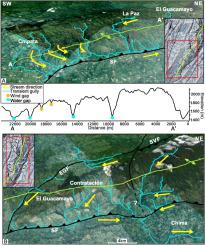当前位置:
X-MOL 学术
›
Geomorphology
›
论文详情
Our official English website, www.x-mol.net, welcomes your feedback! (Note: you will need to create a separate account there.)
Studying active fault-related folding on tectonically inverted orogens: A case study at the Yariguíes Range in the Colombian Northern Andes
Geomorphology ( IF 3.9 ) Pub Date : 2021-02-01 , DOI: 10.1016/j.geomorph.2020.107515 Silvia Machuca , Helbert García-Delgado , Francisco Velandia
Geomorphology ( IF 3.9 ) Pub Date : 2021-02-01 , DOI: 10.1016/j.geomorph.2020.107515 Silvia Machuca , Helbert García-Delgado , Francisco Velandia

|
Abstract Morphometric analysis is widely used in tectonic geomorphology as a useful method for identifying fold activity in terms of its lateral and vertical growth. This study evaluates the recent tectonic activity and lateral propagation of the Los Cobardes anticline (LCA), which built up the Yariguies Range, from morphometric characterization, a structural kinematic analysis, and fieldwork. The study area is located west of the Colombian Eastern Cordillera in a tectonically active region bounded by longitudinal tectonically inverted reverse structures (e.g., the Suarez Fault) with minor transverse faults and the LCA as the central fold of the Yariguies Anticlinorium. A comparison among the precipitation data, lithology, and the morphometric indexes leads us to conclude that for the LCA, recent tectonics drive fold activity. Based on the LCA’s geomorphology and the kinematic analysis derived from fault-slip data, we define three independent fold segments bounded by transverse zones: LCA-A, LCA-B, and LCA-C. Of these, the first two show evidence of lateral propagation toward the southwest, which is closely related to the activity of the Suarez Fault and inherited transverse structures. We found qualitative and quantitative geomorphologic evidence of southwestward propagation: wind and water gaps decreasing in elevation, drainages partially flowing in the direction opposite to the regional trend, and low concavity values for normalized profiles (from -40.49 to 11.76) and Vf (from 0.07 to 0.13). Assisted by published low-temperature thermochronology and seismotectonic data, we demonstrate that the LCA has been growing since the Pliocene and remains active, accommodating deformation in a transpressive stress state. Our findings could serve as a reference to study active fold growth and its structural drivers in known tectonically inverted basins, such as the foreland thrust belt in Argentina, the High Atlas Mountains in Morocco, and the Central Mountain Range of Taiwan, among others.
更新日期:2021-02-01

























 京公网安备 11010802027423号
京公网安备 11010802027423号